- AI
- 30 min read
- February 2025
What is Conversational AI?
Key Takeaways
It’s late at night, and a frustrated customer is trying to get help from an online retailer. They type a question into the chat window, expecting the usual long wait times. Instead, they get an instant, accurate response—followed by a seamless resolution of their issue. No human intervention, no delays, just smooth, intelligent support.
This is conversational AI in action.
In today’s fast-paced digital world, businesses are no longer just competing on products or services—they are competing on customer experience. Conversational AI, powered by advanced natural language processing (NLP), machine learning (ML), and deep learning, is changing the way businesses interact with customers, employees, and stakeholders.
But what exactly is conversational AI? How does it work beneath the surface? And, more importantly, how can businesses leverage it to stay ahead?
This article dives deep into how conversational AI works, breaking down its key components and practical applications. Unlike traditional explainers, this guide is both technical and business-focused, helping you understand not just the “what” but the “how” and “why” behind this game-changing technology.
Let’s get started.
The evolution of conversational AI: From scripts to intelligence
Imagine the early days of customer support chatbots—rigid, rule-based programs that followed a strict script. If you didn’t type the exact phrase they were programmed to recognize, you’d get a frustrating “I don’t understand” response. These basic chatbots relied on decision trees—a predefined set of if/then conditions. They were functional but far from intelligent.
Fast forward to today, and conversational AI has evolved into dynamic, context-aware assistants capable of understanding human language, learning from interactions, and even predicting user intent. But how did we get here?
From rule-based chatbots to AI-powered conversations
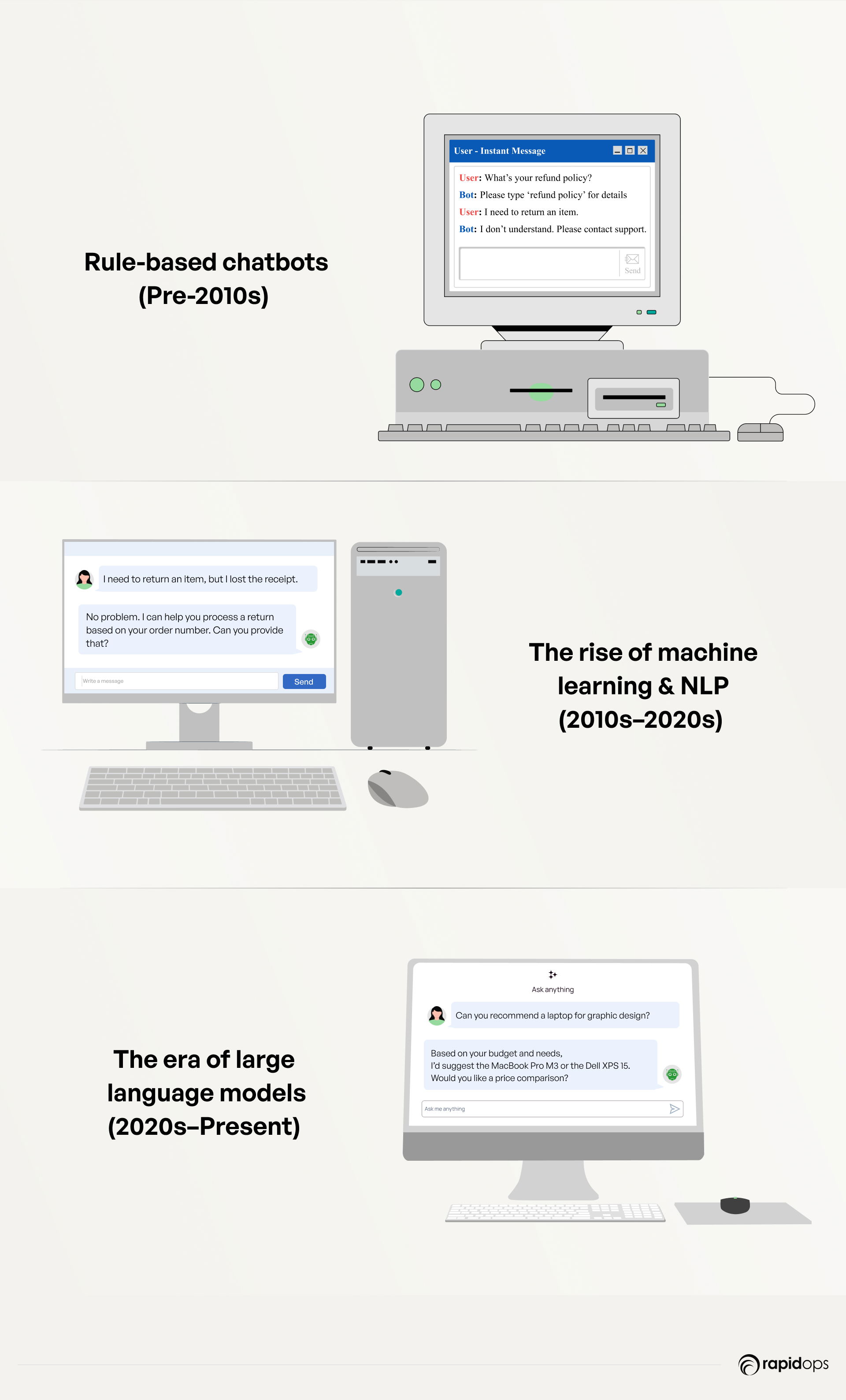
1. Rule-based chatbots (Pre-2010s)
- Relied on predefined scripts and keyword matching.
- Could only handle simple queries with limited flexibility.
- No learning capability—every conversation was independent of past interactions.
Example:
User: “What’s your refund policy?”
Bot: “Please type ‘refund policy’ for details.”
User: “I need to return an item.”
Bot: “I don’t understand. Please contact support.”
2. The rise of machine learning & NLP (2010s–2020s)
- Introduction of natural language processing (NLP) and machine learning (ML).
- AI could understand intent, detect context, and improve over time.
- Ability to handle complex, multi-turn conversations.
Example:
User: “I need to return an item, but I lost the receipt.”
AI: “No problem. I can help you process a return based on your order number. Can you provide that?”
3. The era of large language models (2020s–Present)
- The rise of GPT-based AI and deep learning models.
- AI can generate human-like responses, understand emotions, and provide personalized interactions.
- Voice AI and multimodal interactions (text, voice, video, images) are becoming mainstream.
Example:
User (on voice chat): “Can you recommend a laptop for graphic design?”
AI: “Based on your budget and needs, I’d suggest the MacBook Pro M3 or the Dell XPS 15. Would you like a price comparison?”
Why this evolution matters for businesses
More natural, human-like interactions → Improves customer satisfaction.
Better personalization → AI remembers preferences and past interactions.
Increased automation → Reduces operational costs and scales support efficiently.
Seamless omnichannel experiences → AI works across chat, email, voice, and social media.
Conversational AI is no longer just a customer service tool—it’s a business enabler. The shift from scripted responses to intelligent interactions has unlocked new possibilities for sales, marketing, HR, and operations.
How conversational AI works: A technical breakdown
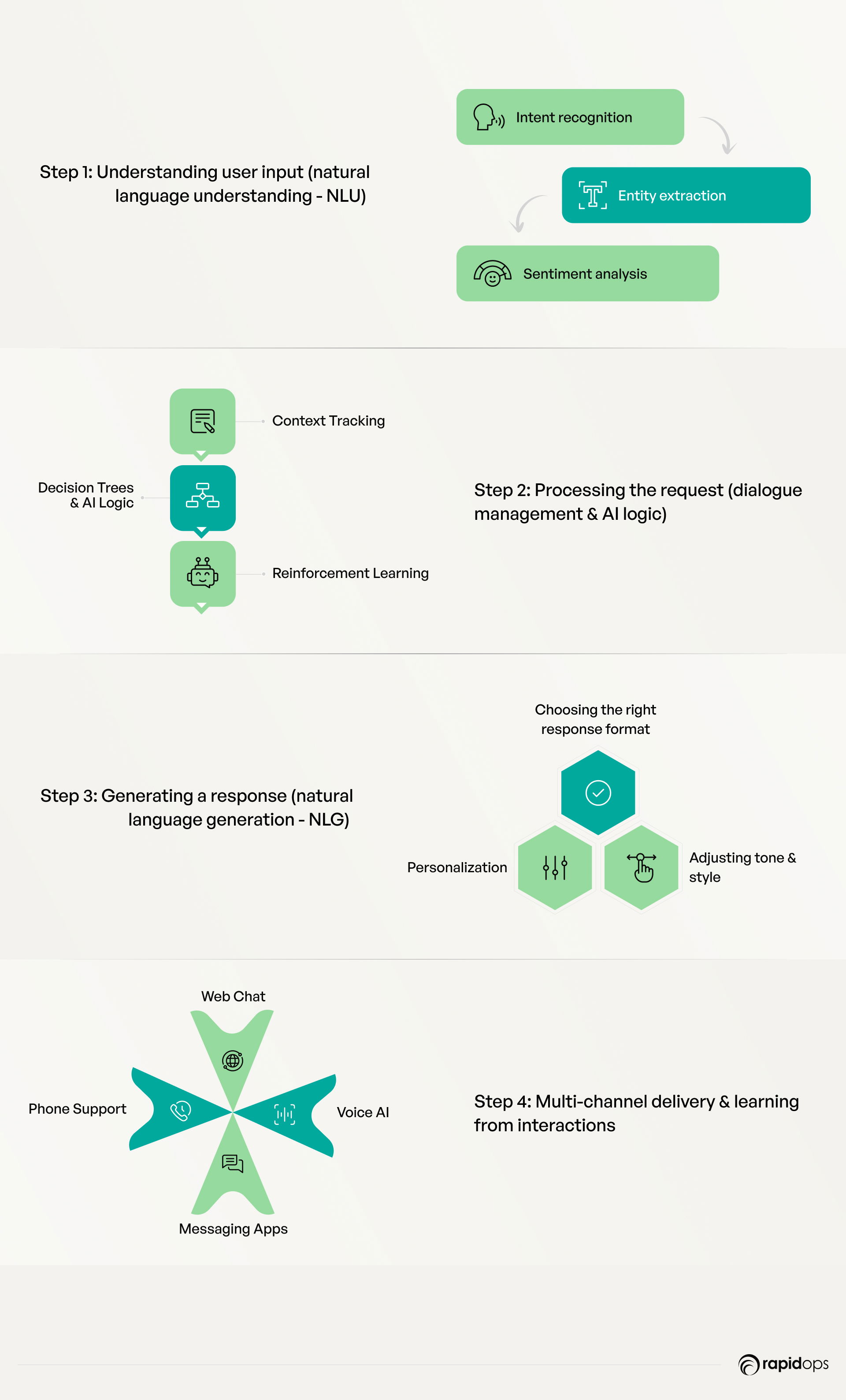
At the heart of conversational AI lies a complex but structured process that enables machines to understand, process, and respond to human language in a way that feels natural. This system is powered by natural language processing (NLP), machine learning (ML), deep learning, and automated decision-making frameworks.
Breaking it down step by step, here’s how conversational AI works under the hood.
Step 1: Understanding user input (natural language understanding - NLU)
Conversational AI begins by processing the user’s input, which could be text or speech. This is where natural language understanding (NLU) plays a crucial role.
NLU involves:
- Intent recognition – Determining what the user wants (e.g., “track my order” implies an intent to check delivery status).
- Entity extraction – Identifying key elements in the query (e.g., recognizing “order number 4567” as an important entity).
- Sentiment analysis – Detecting user emotions to adjust responses accordingly.
For example, if a user types, “My internet is down, and I need urgent help,” an AI-powered support assistant will:
- Recognize the intent (request for technical support).
- Extract entities (“internet” and “urgent help” as indicators of the issue’s severity).
- Adjust tone and urgency based on sentiment analysis (a frustrated customer may require faster escalation).
This process allows AI to move beyond keyword matching and genuinely understand what the user means.
Step 2: Processing the request (dialogue management & AI logic)
Once the intent is identified, the AI must decide how to respond. This is where dialogue management systems come into play.
Key functions include:
- Context tracking – Keeping track of previous exchanges to ensure responses remain relevant.
- Decision trees & AI logic – Choosing the best response based on predefined workflows or AI-generated reasoning.
- Reinforcement learning – Adapting responses based on past interactions and user feedback.
For instance, if a user asks, “What’s the best mobile plan for international travel?”, the AI will:
- Retrieve information about available plans.
- Analyze user history to recommend a personalized option.
- Ask follow-up questions if necessary (“Which country are you traveling to?”).
- A well-designed AI assistant makes these decisions seamlessly, ensuring a natural, engaging conversation.
Step 3: Generating a response (natural language generation - NLG)
After processing the request, the AI must generate a human-like response. This is where natural language generation (NLG) comes in.
Key functions of NLG include:
- Choosing the right response format – Concise text, detailed explanation, or links to resources.
- Adjusting tone and style – A casual tone for e-commerce chatbots, a formal tone for banking AI.
- Personalization – Using customer data to make responses more relevant.
For example, if a customer asks, “Can you help me reset my password?”, the AI might respond:
- Basic AI: “To reset your password, visit the reset page.”
- Advanced AI: “I can guide you through resetting your password. Would you like to receive a reset link via email or SMS?”
This adaptability is what makes conversational AI feel intuitive and user-friendly.
Step 4: Multi-channel delivery & learning from interactions
Conversational AI operates across multiple platforms, including:
- Web chat – Live chat assistants on websites.
- Voice AI – Smart assistants like Alexa or Google Assistant.
- Messaging apps – AI-powered WhatsApp, Facebook Messenger, or Slack bots.
- Phone support – Interactive voice response (IVR) systems.
Beyond responding to users, AI also learns over time through:
- Supervised learning – AI is fine-tuned using feedback from human trainers.
- Reinforcement learning – AI adjusts responses based on success rates.
- Self-learning models – AI improves autonomously by analyzing thousands of interactions.
For businesses, this means AI is constantly evolving, leading to better accuracy, reduced response times, and improved customer experience.
The core technologies powering conversational AI
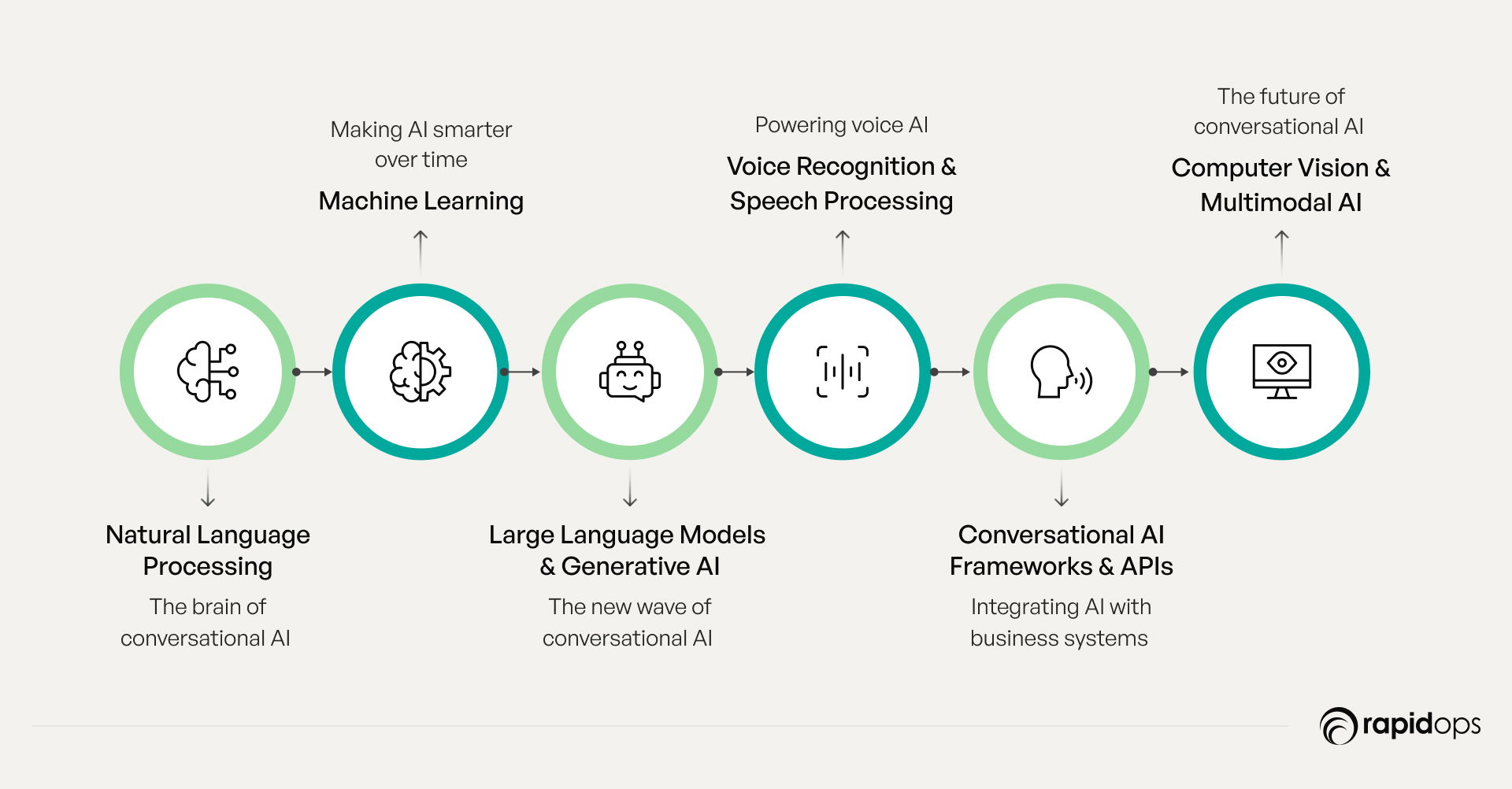
Conversational AI relies on a combination of advanced technologies that work together to enable machines to understand, process, and respond to human interactions in a natural and meaningful way.
These technologies form the backbone of AI-powered chatbots, virtual assistants, and voice AI solutions that businesses use today.
Here’s a deep dive into the essential technologies behind conversational AI.
1. Natural language processing (NLP): The brain of conversational AI
Natural language processing (NLP) is the core technology that allows AI to understand human language in a structured way. It enables chatbots and voice assistants to interpret and process text or speech, recognize meaning, and generate appropriate responses.
NLP consists of two key components:
- Natural language understanding (NLU) – Helps AI understand user intent, extract important information, and determine the context.
- Natural language generation (NLG) – Enables AI to generate human-like responses in a grammatically correct and contextually relevant manner.
For example, if a user asks, “What’s the weather like in Dubai today?”, NLP allows AI to:
- Recognize "weather" as the intent.
- Extract "Dubai" as the location entity.
- Retrieve relevant weather data and generate a structured response.
NLP has significantly improved with deep learning, making AI assistants more accurate and capable of handling complex queries, multiple intents, and sentiment variations.
2. Machine learning (ML) & deep learning: Making AI smarter over time
While NLP focuses on understanding language, machine learning (ML) enables AI to learn from past interactions and continuously improve.
Key aspects of ML in conversational AI include:
- Supervised learning – AI is trained using labeled datasets where human trainers provide correct responses.
- Unsupervised learning – AI analyzes patterns in conversations without human intervention.
- Reinforcement learning – AI learns from real-world interactions, improving its responses based on positive or negative feedback.
Deep learning, a subset of ML, uses neural networks to mimic the human brain's way of processing information.
Large-scale deep learning models, such as transformer-based architectures like GPT (Generative Pre-trained Transformer), BERT (Bidirectional Encoder Representations from Transformers), and T5 (Text-to-Text Transfer Transformer), have revolutionized conversational AI by making it:
- More contextually aware in conversations.
- Better at understanding long-form queries.
- Capable of handling multi-turn dialogues and remembering past interactions.
For example, in customer service, AI chatbots trained on ML can recognize repeat customers, predict queries based on history, and personalize interactions over time. At the same time, you can train AI agents to have friendly conversations with your customers to increase conversion rates.
3. Large language models (LLMs) & generative AI: The new wave of conversational AI
Recent advancements in large language models (LLMs), such as OpenAI's GPT-4 and Google's Gemini, have significantly enhanced AI's ability to converse with humans naturally and dynamically.
Key benefits of LLMs in conversational AI include:
- Better context retention – AI remembers the conversation flow across multiple exchanges.
- More natural responses – AI-generated text sounds more human-like.
- Faster training with fewer data points – LLMs can learn with minimal supervision.
These models allow AI-powered assistants to go beyond scripted interactions, enabling more fluid, nuanced conversations that feel less robotic.
4. Voice recognition & speech processing: Powering voice AI
With the rise of voice assistants like Alexa, Siri, and Google Assistant, speech-to-text (STT) and text-to-speech (TTS) technologies have become integral to conversational AI.
- Speech-to-text (STT): Converts spoken language into written text for AI to process.
- Text-to-speech (TTS): Converts AI-generated text into natural-sounding speech.
Advanced speech recognition models, trained on large datasets, can now:
- Recognize various accents, dialects, and speech patterns.
- Understand background noise and context in real-world environments.
- Generate realistic AI voices with emotions and variations in tone.
For example, in banking and finance, voice AI is used for fraud detection, authentication, and voice-based customer support, ensuring seamless interactions.
5. Conversational AI frameworks & APIs: Integrating AI with business systems
To deploy conversational AI in a business setting, companies use AI frameworks and APIs that enable seamless integration with existing applications and data sources.
Some of the most widely used conversational AI frameworks include:
- Google Dialogflow – A cloud-based NLP tool for building chatbots and voice AI.
- IBM Watson Assistant – An enterprise AI assistant with industry-specific capabilities.
- Microsoft Bot Framework – A development platform for creating AI-powered chat experiences.
- Amazon Lex – The AI service behind Alexa, used for building conversational interfaces.
APIs and connectors allow conversational AI to:
- Access CRM, ERP, and customer support systems to provide personalized responses.
- Retrieve real-time data from databases to offer up-to-date information.
- Automate workflows by integrating with business automation tools like Zapier or RPA solutions.
For instance, in e-commerce, AI chatbots integrated with an inventory management system can instantly check product availability and suggest alternatives if an item is out of stock.
6. Computer vision & multimodal AI: The future of conversational AI
The next generation of conversational AI is moving beyond text and speech to include computer vision and multimodal AI, enabling AI to understand and respond to visual and textual inputs simultaneously.
Emerging capabilities include:
- AI assistants that analyze facial expressions and body language during video calls.
- Smart retail AI that processes images of products and answers customer queries based on visuals.
- Healthcare AI that interprets medical images and provides verbal explanations to doctors and patients.
As businesses look to create fully immersive AI-driven experiences, multimodal AI will play a key role in shaping how conversational AI interacts with users across different formats.
With these technologies powering conversational AI, businesses can deploy highly sophisticated AI assistants that streamline operations, enhance customer experiences, and drive efficiency.
Conversational AI in action: Real-world business use cases
Conversational AI is no longer just a futuristic concept—it’s already transforming customer service, sales, marketing, HR, and operations across industries. Businesses are using AI-powered chatbots and voice assistants to automate processes, enhance customer engagement, and drive revenue growth.
Let’s explore some of the most impactful use cases of conversational AI in business.
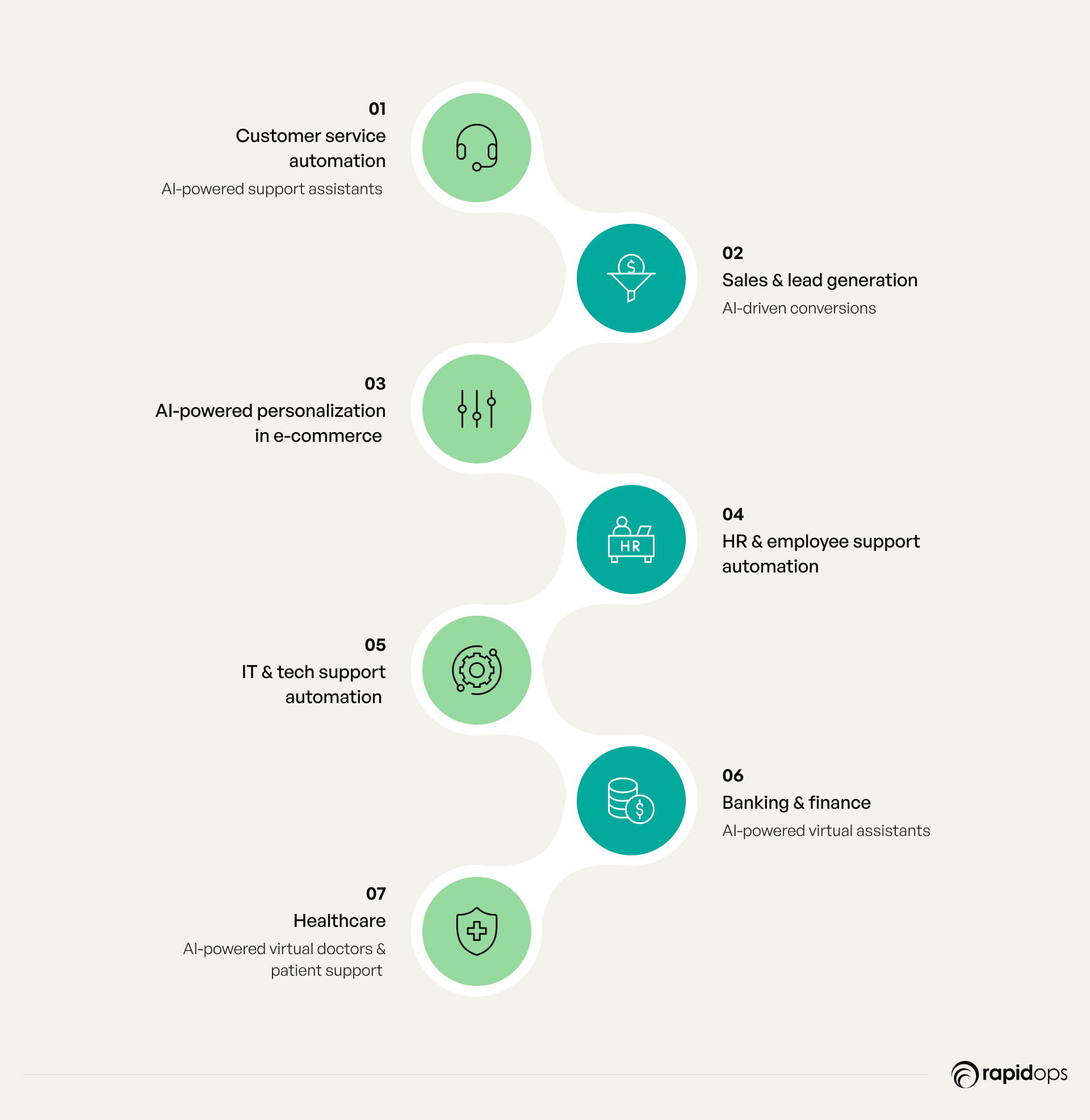
1. Customer service automation: AI-powered support assistants
Use case: AI-driven chatbots and virtual assistants handle customer inquiries, reducing the workload on human agents while improving response times.
How it works:
- AI chatbots integrate with customer relationship management (CRM) systems to retrieve past interactions.
- Natural language processing (NLP) enables AI to understand user queries, even if phrased differently than expected.
- AI identifies when a human escalation is necessary, ensuring a seamless transition from chatbot to agent.
Business impact:
- Reduces customer support costs by up to 30%.
- Enables 24/7 support without the need for human intervention.
- Improves customer satisfaction by providing instant responses.
Example:
E-commerce companies use AI chatbots to track orders, process returns, and handle refunds without human involvement.
2. Sales & lead generation: AI-driven conversions
Use case: AI-powered chatbots qualify leads, guide prospects through the sales funnel, and increase conversion rates.
How it works:
- AI bots initiate conversations with website visitors and ask pre-qualifying questions.
- AI categorizes leads based on intent, budget, and readiness to buy.
- AI assistants schedule meetings, send follow-up emails, and nurture leads automatically.
Business impact:
- Increases lead conversion rates by 10-15%.
- Reduces human workload in cold calling and initial qualification.
- Enhances personalization by analyzing past customer interactions.
Example:
B2B companies use AI chatbots to qualify leads by asking, “Are you looking for a solution for small or large teams?”, then routing them to the right sales representative.
3. AI-powered personalization in e-commerce
Use case: AI personalizes product recommendations based on customer behavior, purchase history, and browsing patterns.
How it works:
- AI chatbots analyze customer click patterns and previous purchases to suggest relevant products.
- AI assists in shopping by answering product-related queries in real-time.
- AI integrates with inventory systems to inform customers about stock availability.
Business impact:
- Increases average order value by recommending related products.
- Boosts customer engagement by offering a tailored shopping experience.
- Reduces cart abandonment by sending personalized follow-ups.
Example:
Retail websites use AI chatbots that say, “Customers who bought this item also liked…”, influencing purchasing decisions.
4. HR & employee support automation
Use case: AI assists HR teams by automating onboarding, answering employee queries, and managing administrative tasks.
How it works:
- AI chatbots act as virtual HR assistants, providing instant answers about leave policies, benefits, and payroll.
- AI-powered systems automate onboarding workflows, guiding new employees through paperwork.
- AI integrates with internal knowledge bases to provide accurate responses.
Business impact:
- Reduces HR workload by handling 80% of repetitive queries.
- Improves employee experience by providing instant access to HR information.
- Speeds up the hiring and onboarding process through automation.
Example:
Large corporations use AI HR chatbots where employees can ask, “How many vacation days do I have left?”, and receive an instant response without HR intervention.
5. IT & tech support automation
Use case: AI-driven IT support assistants troubleshoot issues, manage tickets, and provide instant solutions to employees.
How it works:
- AI assistants use NLP to diagnose tech problems based on user descriptions.
- AI-powered bots generate automated troubleshooting steps.
- AI integrates with IT helpdesk platforms to track and resolve support tickets.
Business impact:
- Reduces IT support workload by automating up to 60% of queries.
- Shortens downtime by providing instant issue resolution steps.
- Improves efficiency by prioritizing critical IT issues automatically.
Example:
AI chatbots in IT helpdesks can resolve issues like, “Why is my VPN not working?”, by providing step-by-step troubleshooting solutions.
6. Banking & finance: AI-powered virtual assistants
Use case: Banks and financial institutions use AI-driven virtual assistants for customer inquiries, fraud detection, and account management.
How it works:
- AI chatbots assist customers in checking balances, making payments, and tracking expenses.
- AI-driven fraud detection systems monitor transaction patterns and flag suspicious activity.
- AI provides automated investment advice based on customer financial goals.
Business impact:
- Improves customer experience with instant banking support.
- Enhances security by detecting fraud patterns in real time.
- Reduces reliance on human agents for basic account-related queries.
Example:
A banking AI assistant can handle questions like, “What’s my account balance?”, and process transactions without requiring a human banker.
7. Healthcare: AI-powered virtual doctors & patient support
Use case: AI-powered chatbots assist patients with appointment scheduling, symptom checking, and medical queries.
How it works:
- AI chatbots use medical knowledge databases to provide accurate health advice.
- AI assists in appointment booking, reminders, and post-visit follow-ups.
- AI-powered diagnostic assistants help doctors analyze symptoms and suggest potential conditions.
Business impact:
- Reduces hospital wait times by automating pre-diagnosis.
- Increases accessibility to healthcare services 24/7.
- Supports remote healthcare and telemedicine services.
Example:
A healthcare chatbot can answer, “What are the symptoms of the flu?”, based on verified medical data, before guiding the patient to the right specialist.
Building a conversational AI system for your business
Implementing conversational AI is not just about deploying a chatbot or voice assistant; it requires a strategic approach to ensure that the AI aligns with business goals, integrates seamlessly with existing systems, and enhances user experience.
This section provides a practical, step-by-step guide for businesses looking to implement conversational AI effectively.
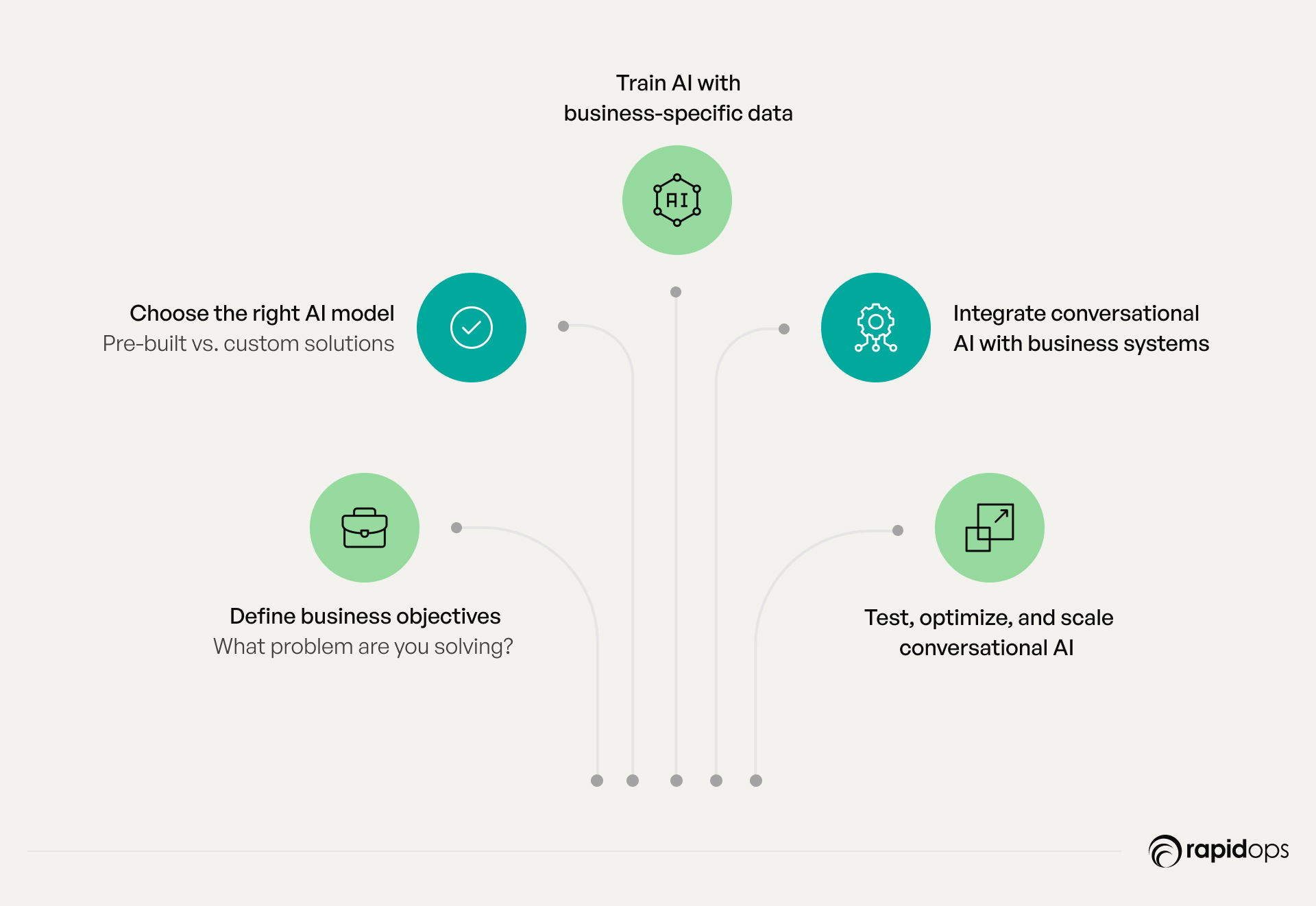
1. Define business objectives: What problem are you solving?
Before selecting an AI solution, businesses must define their primary use case. Conversational AI can serve various purposes, such as:
- Customer support automation – Reducing response times and agent workload.
- Lead generation – Engaging website visitors and qualifying prospects.
- Sales enablement – Assisting in product recommendations and transactions.
- HR and internal support – Automating employee queries and onboarding.
- IT helpdesk automation – Resolving technical issues and managing support tickets.
Clearly outlining the desired outcomes will help in choosing the right conversational AI model and features.
2. Choose the right AI model: Pre-built vs. custom solutions
Once objectives are defined, businesses must decide whether to use pre-built AI platforms or develop custom AI models.
Option 1: Pre-built conversational AI platforms
These platforms offer ready-to-use AI assistants with built-in NLP, machine learning, and integrations.
Best for: Businesses that need a quick deployment with minimal customization.
Popular options:
- Google Dialogflow – NLP-powered chatbot with Google Cloud integration.
- IBM Watson Assistant – Enterprise AI with analytics and customization.
- Amazon Lex – AI-driven conversational experiences for customer service.
- Microsoft Bot Framework – AI development platform for custom chatbot solutions.
Option 2: Custom-built conversational AI models
For businesses that require highly specialized AI, custom-built models trained on proprietary data may be necessary.
Best for: Companies with specific industry requirements and large data sets for training AI.
Development approach:
- Use machine learning frameworks like TensorFlow or PyTorch.
- Train AI on industry-specific datasets for better accuracy.
- Implement custom NLP models to refine language understanding.
Choosing the right approach depends on business needs, budget, and technical expertise.
3. Train AI with business-specific data
Even the most advanced AI requires training on relevant business data to perform effectively.
Key steps in AI training:
- Data collection – Gather structured and unstructured data (chat logs, FAQs, past customer interactions).
- Data labeling – Classify and tag datasets to train AI on intent recognition and response generation.
- Supervised learning – Use human training to refine AI understanding and improve accuracy.
- Continuous learning – AI must evolve based on user interactions and feedback loops.
For example, an AI assistant in the insurance industry should be trained with claims processing data to answer policy-related questions accurately.
The more relevant data AI is trained on, the better it performs in real-world business conversations.
4. Integrate conversational AI with business systems
Conversational AI must seamlessly connect with existing business infrastructure to function efficiently.
Essential integrations include:
- CRM systems (Salesforce, HubSpot) – AI retrieves customer history for personalized interactions.
- E-commerce platforms (Shopify, Magento) – AI assists in product recommendations and transactions.
- HR & employee management tools (Workday, BambooHR) – AI automates employee support and onboarding.
- IT helpdesk solutions (ServiceNow, Jira) – AI streamlines IT ticketing and troubleshooting.
For example:
A banking AI chatbot integrated with core banking APIs can allow users to check balances, transfer funds, and request account details instantly.
Integration ensures conversational AI is not just an isolated tool but a powerful extension of business operations.
5. Test, optimize, and scale conversational AI
Once deployed, conversational AI requires continuous monitoring and optimization to improve performance.
Best practices for AI optimization:
- A/B testing – Compare AI-generated responses to measure effectiveness.
- User feedback loops – Collect customer ratings and feedback on AI interactions.
- Performance analytics – Track AI accuracy, resolution time, and engagement rates.
- Human fallback mechanisms – Ensure smooth handoffs to human agents when AI cannot resolve queries.
Scaling AI requires expanding its capabilities across multiple channels, languages, and customer segments while ensuring a consistent experience.
The challenges of implementing conversational AI (and how to overcome them)
While conversational AI offers immense benefits, its successful implementation comes with technical, operational, and user experience challenges. Businesses need to address these challenges strategically to ensure AI adoption enhances, rather than disrupts, operations.
Below are the key challenges and practical solutions to overcoming them.
1. Data security and privacy concerns
The challenge:

Conversational AI deals with sensitive user data, including personal, financial, and transactional information. Improper data handling can lead to compliance violations, security breaches, and loss of customer trust.
How to overcome it:
- Data encryption & secure storage – Implement end-to-end encryption and secure cloud storage to protect user conversations.
- Compliance with regulations – Ensure AI systems comply with GDPR, CCPA, HIPAA, and other data protection laws.
- Anonymization of sensitive data – Mask or remove personally identifiable information (PII) to prevent unauthorized access.
- Regular security audits – Continuously assess AI vulnerabilities to detect and mitigate risks.
For instance, a banking AI assistant must follow strict encryption protocols to ensure financial transactions and user authentication remain secure.
2. Training AI for high accuracy and contextual understanding
The challenge:

AI models often struggle with complex conversations that require deep contextual understanding. If trained on limited datasets, AI may produce inaccurate, irrelevant, or generic responses.
How to overcome it:
- Use domain-specific training data – Train AI on industry-relevant datasets to improve accuracy (e.g., legal AI trained on case laws).
- Continuous learning from real-world interactions – Implement reinforcement learning so AI can improve over time.
- Human-in-the-loop training – Incorporate human feedback to refine AI’s responses and reduce errors.
- Multi-turn dialogue management – Enable AI to remember context across multiple exchanges rather than treating each query in isolation.
For example, in customer support, AI should retain conversation history to recognize that a user asking, "Where is my package?" and then, "Can I change the delivery address?", is referring to the same order.
3. Balancing AI automation with human support
The challenge:
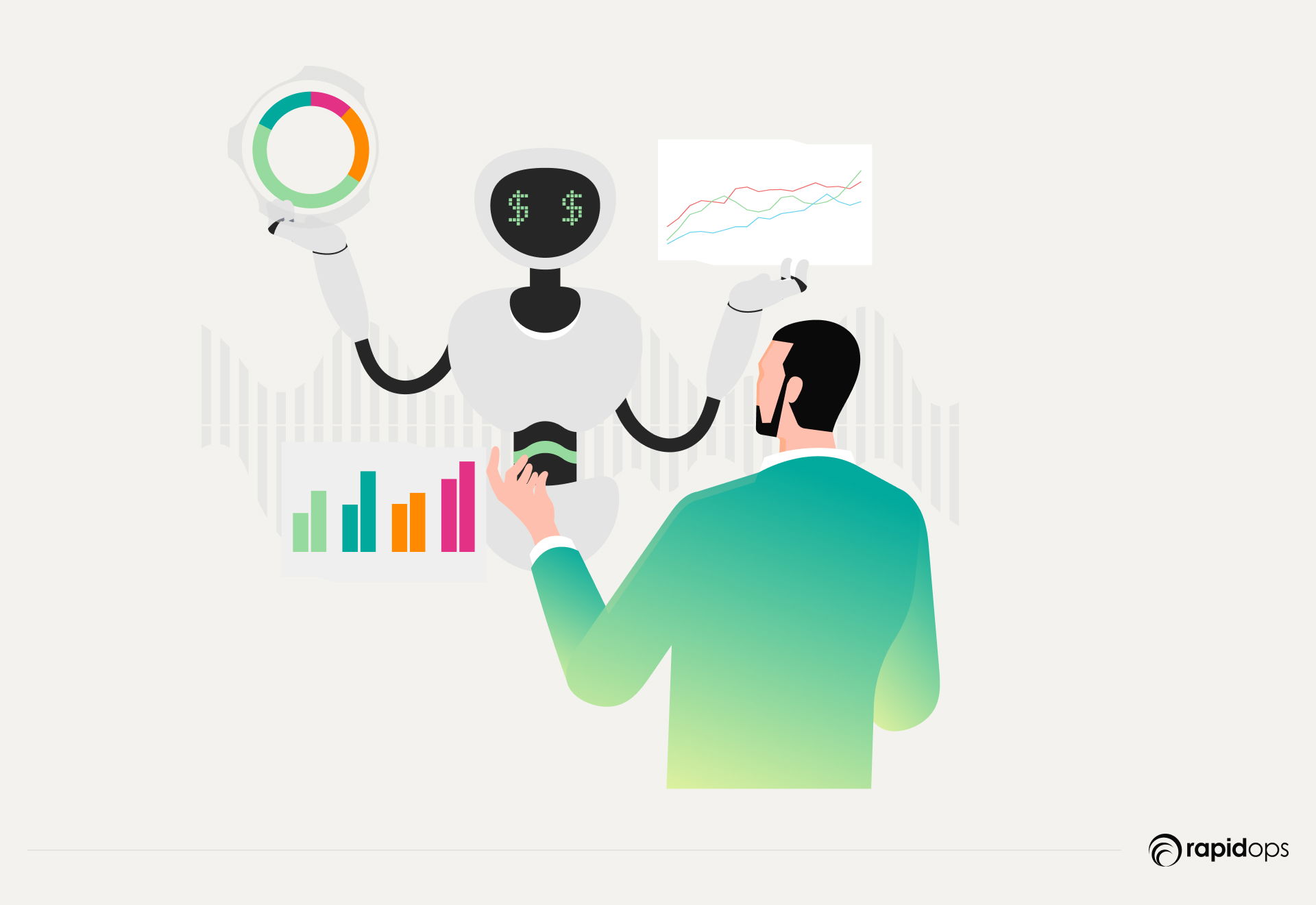
While AI chatbots and virtual assistants handle routine queries efficiently, they cannot replace human empathy and complex decision-making. Businesses often struggle to find the right balance between AI and human agents.
How to overcome it:
- Set clear AI limitations – AI should handle routine and structured queries, while complex cases are escalated to human agents.
- Seamless AI-to-human handoff – Implement smart routing where AI automatically transfers users to a human agent when necessary.
- Hybrid AI models – Use AI for preliminary query resolution and let human agents step in when nuanced problem-solving is required.
- Maintain transparency – Users should always be aware when they are interacting with AI, and an option to speak with a human should be available.
For example, in healthcare AI, chatbots can help schedule appointments, but critical diagnoses must be handled by medical professionals.
4. Handling multiple languages and dialects
The challenge:

Conversational AI must cater to global audiences who speak different languages, accents, and dialects. Traditional AI models often struggle with language variations, informal speech, and cultural nuances.
How to overcome it:
- Deploy multilingual AI models – Train AI on multiple language datasets to improve performance in different regions.
- Use translation APIs – Integrate with Google Translate API or Microsoft Translator for real-time language support.
- Context-aware translations – AI should recognize slang, industry-specific terminology, and local idioms for natural conversations.
- Region-specific NLP tuning – Optimize AI for local customer preferences to enhance engagement.
For example, an AI chatbot for a global airline should understand and respond in multiple languages while maintaining accurate translations of flight details.
5. Managing AI bias and ethical concerns
The challenge:

Conversational AI learns from historical data, which may contain biases related to gender, race, and economic background. If not monitored, AI could unintentionally generate biased or discriminatory responses.
How to overcome it:
- Diverse and inclusive training datasets – Train AI on varied, unbiased datasets to prevent skewed decision-making.
- Regular bias audits – Continuously evaluate AI responses for potential biases and adjust models accordingly.
- Ethical AI governance – Establish guidelines on AI fairness and responsible deployment within the organization.
- Explainable AI (XAI) – Ensure AI decisions are transparent and justifiable rather than operating as a black box.
For example, an AI-powered hiring assistant should not discriminate against candidates based on historical biases in recruitment data.
6. User adoption and trust in AI interactions
The challenge:
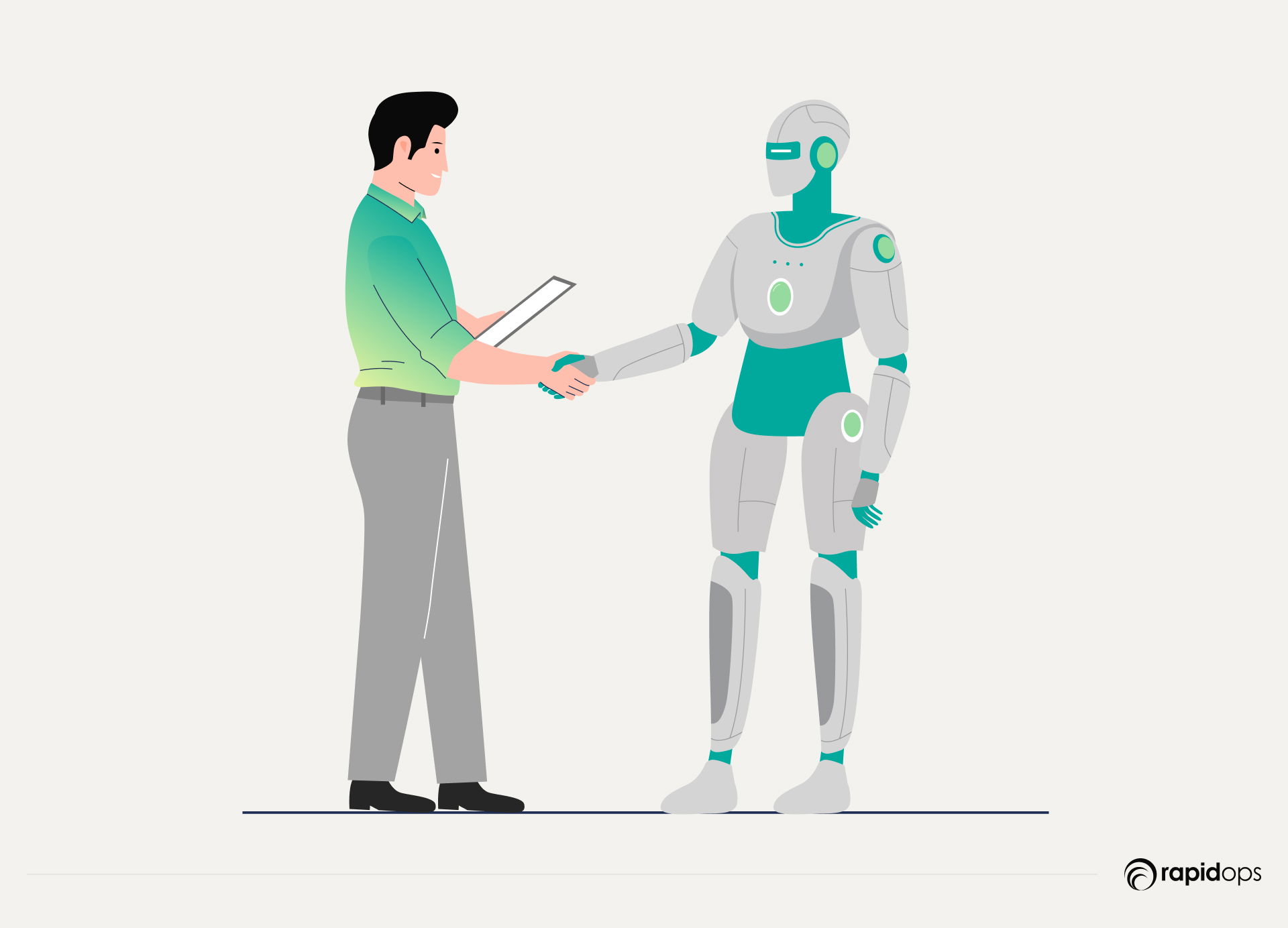
Many users are skeptical of AI due to past experiences with unhelpful chatbots or fears about AI replacing human jobs. If AI lacks credibility and effectiveness, users will be reluctant to engage.
How to overcome it:
- Educate users about AI’s capabilities and limitations – Clarify what AI can and cannot do.
- Ensure AI delivers accurate and useful responses – Poor AI performance can damage brand reputation.
- Make AI interactions feel natural – AI should mimic human-like conversations while being upfront about its non-human nature.
- Build user confidence with transparency – Provide clear messaging on data privacy, AI decision-making, and security measures.
For example, AI-driven virtual banking assistants should reassure users that financial data is protected, and they can always request human assistance when needed.
7. Maintenance, scalability, and cost considerations
The challenge:

Conversational AI requires continuous updates, monitoring, and scaling as business needs evolve. Many companies struggle with:
- Keeping AI up to date with new products, services, and policies.
- Managing infrastructure costs as AI usage increases.
- Scaling AI to handle larger volumes of queries efficiently.
How to overcome it:
- Set up continuous AI training – Regularly update AI with new business data, user queries, and industry trends.
- Leverage cloud-based AI platforms – Scalable solutions like Google Cloud AI, AWS AI, and Azure AI reduce infrastructure burdens.
- Use AI analytics to optimize performance – Track user interactions, AI response accuracy, and system efficiency to improve over time.
- Implement cost-effective AI scaling strategies – Use chatbot deflection to reduce human support costs while maintaining quality service.
For example, a large e-commerce company may start with a single AI chatbot for FAQs, then scale AI to handle personalized product recommendations and order processing as demand grows.
The future of conversational AI: What’s next?
Conversational AI is advancing at an unprecedented pace, and the next wave of innovations will reshape how businesses operate, communicate, and engage with customers. While today’s AI systems can generate text, handle voice interactions, and offer personalization, future advancements will push AI toward true autonomy, real-time decision-making, and immersive AI-human interactions.
Here’s what’s coming next.
1. Multimodal AI: beyond words to full sensory interactions
AI is moving from text and voice-based communication to fully multimodal experiences, where AI understands and responds using sight, sound, and even touch.
How it will impact businesses:
- AI assistants will analyze video feeds and facial expressions to gauge customer emotions and adjust interactions accordingly.
- Retail AI will allow customers to show a product image and ask, “Do you have something similar?” without typing a description.
- AI in virtual meetings will summarize discussions in real time, extract key action points, and provide follow-ups.
The next step: Businesses will shift toward AI-powered environments where interactions happen seamlessly across voice, text, video, and augmented reality (AR) interfaces.
2. Autonomous AI agents: AI making real business decisions
Today’s conversational AI is reactive—it answers questions and follows instructions. The future will bring AI that proactively acts on behalf of businesses and users.
How it will impact businesses:
- AI-powered autonomous financial advisors will analyze real-time market trends and make investment decisions without human intervention.
- AI-driven procurement bots will automatically negotiate supplier contracts based on market price fluctuations and inventory levels.
- AI-powered legal assistants will draft custom contracts, verify compliance, and flag potential legal risks before they occur.
The next step: AI will move from being an assistant to an independent decision-maker, optimizing supply chains, executing transactions, and resolving disputes autonomously.
3. AI with real-world memory and long-term contextual awareness
Currently, AI models (like ChatGPT) rely on short-term memory in a single conversation but do not retain long-term knowledge across interactions. Future AI will remember and adapt to past conversations, business contexts, and user-specific needs—creating a consistent, evolving relationship between AI and users.
How it will impact businesses:
- AI customer support agents will remember past user complaints and proactively follow up, asking, “Last time you called, we fixed a billing issue. Is everything working fine now?”
- AI-powered HR assistants will track employee career progress, recommend skill development courses, and guide individuals toward promotions.
- AI-powered B2B sales assistants will remember previous client discussions, offering tailored product recommendations based on evolving business needs.
The next step: AI will evolve from a transactional tool to a relationship-driven partner for businesses, employees, and customers.
4. Neuro-symbolic AI: combining deep learning with reasoning
Most AI today relies on deep learning, meaning it predicts answers based on patterns in vast amounts of data. The next evolution—neuro-symbolic AI—will enable machines to not only predict but also reason using logic and structured decision-making.
How it will impact businesses:
- AI legal assistants will not just analyze contracts but apply legal reasoning to suggest alternative clauses based on case law.
- AI doctors will not just recognize symptoms but apply logical reasoning to diagnose rare diseases.
- AI auditors will not just flag financial inconsistencies but explain why they are violations using business rules.
The next step: Businesses will rely on AI not just for automation, but for strategic decision-making that requires logical reasoning and explanation.
5. AI-driven virtual beings and hyper-realistic avatars
As AI advances, we will see the emergence of fully digital, AI-driven virtual beings that can hold conversations, express emotions, and interact with customers as if they were human.
How it will impact businesses:
- AI-driven virtual salespeople will assist customers in digital stores, offering personalized recommendations based on real-time behavior analysis.
- AI-powered virtual HR interviewers will conduct job interviews, assess candidates, and provide feedback based on speech patterns and qualifications.
- AI-powered virtual brand ambassadors will create engaging social media content, interact with followers, and influence purchasing decisions.
The next step: Businesses will replace traditional customer service and marketing interactions with hyper-realistic AI avatars that simulate human interactions in real time.
6. AI-integrated brain-computer interfaces (BCIs)
The most radical transformation in conversational AI will come from direct AI-to-brain communication, where AI will interact with users without the need for keyboards, screens, or voice commands.
How it will impact businesses:
- Employees will use AI-powered brain interfaces to instantly retrieve business insights without typing or clicking.
- AI-powered hands-free communication tools will allow doctors, engineers, and factory workers to operate machines using thought-based commands.
- AI-driven productivity assistants will detect mental fatigue and recommend breaks, meditation, or work prioritization.
The next step: Businesses will integrate brain-computer interfaces into enterprise AI systems, creating a world where decisions and actions happen through thought-powered AI interactions.
Conclusion: Embracing the future of conversational AI
Conversational AI is no longer a luxury—it is a business necessity. Companies that leverage AI-powered automation, intelligent decision-making, and next-generation interactions will gain a competitive edge in customer engagement, efficiency, and revenue growth.
At Rapidops, we specialize in cutting-edge AI solutions that help businesses integrate conversational AI seamlessly into their operations. Whether you're looking to automate customer interactions, optimize workflows, or scale AI-driven decision-making, our team of AI experts is ready to help.
Want to explore how AI can transform your business? Book a cost-free consultation call with our AI specialists today and discover the best AI strategy tailored to your business needs.
Frequently Asked Questions
What are the benefits of conversational AI for businesses?
How is conversational AI different from traditional chatbots?
What are the key technologies behind conversational AI?
How can businesses implement conversational AI effectively?
What is the future of conversational AI in business?
What’s Inside
- From rule-based chatbots to AI-powered conversations
- Why this evolution matters for businesses
- How conversational AI works: A technical breakdown
- The core technologies powering conversational AI
- Conversational AI in action: Real-world business use cases
- Building a conversational AI system for your business
- The challenges of implementing conversational AI (and how to overcome them)
- The future of conversational AI: What’s next?
- Conclusion: Embracing the future of conversational AI




